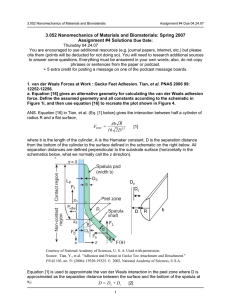3.052 Nanomechanics of Materials and Biomaterials : Spring 2007 Assignment #1
advertisement
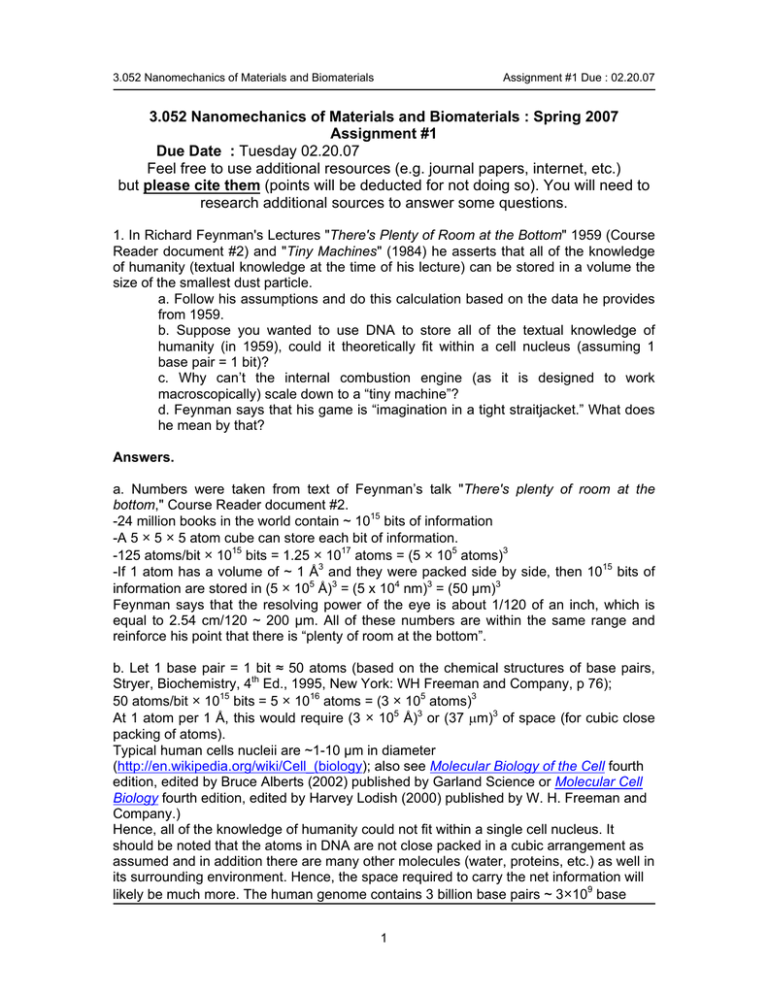
3.052 Nanomechanics of Materials and Biomaterials Assignment #1 Due : 02.20.07 3.052 Nanomechanics of Materials and Biomaterials : Spring 2007 Assignment #1 Due Date : Tuesday 02.20.07 Feel free to use additional resources (e.g. journal papers, internet, etc.) but please cite them (points will be deducted for not doing so). You will need to research additional sources to answer some questions. 1. In Richard Feynman's Lectures "There's Plenty of Room at the Bottom" 1959 (Course Reader document #2) and "Tiny Machines" (1984) he asserts that all of the knowledge of humanity (textual knowledge at the time of his lecture) can be stored in a volume the size of the smallest dust particle. a. Follow his assumptions and do this calculation based on the data he provides from 1959. b. Suppose you wanted to use DNA to store all of the textual knowledge of humanity (in 1959), could it theoretically fit within a cell nucleus (assuming 1 base pair = 1 bit)? c. Why can’t the internal combustion engine (as it is designed to work macroscopically) scale down to a “tiny machine”? d. Feynman says that his game is “imagination in a tight straitjacket.” What does he mean by that? Answers. a. Numbers were taken from text of Feynman’s talk "There's plenty of room at the bottom," Course Reader document #2. -24 million books in the world contain ~ 1015 bits of information -A 5 × 5 × 5 atom cube can store each bit of information. -125 atoms/bit × 1015 bits = 1.25 × 1017 atoms = (5 × 105 atoms)3 -If 1 atom has a volume of ~ 1 Å3 and they were packed side by side, then 1015 bits of information are stored in (5 × 105 Å)3 = (5 x 104 nm)3 = (50 µm)3 Feynman says that the resolving power of the eye is about 1/120 of an inch, which is equal to 2.54 cm/120 ~ 200 µm. All of these numbers are within the same range and reinforce his point that there is “plenty of room at the bottom”. b. Let 1 base pair = 1 bit ≈ 50 atoms (based on the chemical structures of base pairs, Stryer, Biochemistry, 4th Ed., 1995, New York: WH Freeman and Company, p 76); 50 atoms/bit × 1015 bits = 5 × 1016 atoms = (3 × 105 atoms)3 At 1 atom per 1 Å, this would require (3 × 105 Å)3 or (37 μm)3 of space (for cubic close packing of atoms). Typical human cells nucleii are ~1-10 µm in diameter (http://en.wikipedia.org/wiki/Cell_(biology); also see Molecular Biology of the Cell fourth edition, edited by Bruce Alberts (2002) published by Garland Science or Molecular Cell Biology fourth edition, edited by Harvey Lodish (2000) published by W. H. Freeman and Company.) Hence, all of the knowledge of humanity could not fit within a single cell nucleus. It should be noted that the atoms in DNA are not close packed in a cubic arrangement as assumed and in addition there are many other molecules (water, proteins, etc.) as well in its surrounding environment. Hence, the space required to carry the net information will likely be much more. The human genome contains 3 billion base pairs ~ 3×109 base 1 3.052 Nanomechanics of Materials and Biomaterials Assignment #1 Due : 02.20.07 pairs (see DoE genome webpages: http://www.ornl.gov/sci/techresources/Human_Genome/faq/faqs1.shtml) = 3×109 bits of information. c. In a macroscopic internal combustion engine some of the heat generated in the explosion is lost by heating up the walls of the cylinder. However, it is not so significant compared to the heat needed to expand the gas. When scaling down, the volume goes down as the cube of the relevant length, L3, while the surface area scales down as the square L2. So the heat will leak into the casing much faster and the engine will be relatively ineffective. d. Feynman is referring to the fact that when inventing or engineering new things, one still has to obey the basic laws of physics. 2. Aggrecan is a very unique "bottle-brush" macromolecule that is largely responsible for the mechanical properties and health of cartilage tissue in our joints (later on in the semester you will hear a podcast with Professor Alan Grodzinsky on this topic). Aggrecan is composed of highly negatively charged polysaccharides called glycosaminoglycans or GAGs (contour length ~ 40 nm) as side chains that are densely packed along a core protein (contour length ~ 400 nm). Aggrecan was chemically endattached to a planar substrate and a micron-sized probe tip at the end of a microfabricated cantilever at a packing density of 25 nm × 25 nm square per aggrecan molecule. A high resolution force spectroscopy experiment was then carried out where the surfaces were compressed and held for a period of time between the approach and retract curves (Figure 1 - real data taken in the last month!). The uncompressed and compressed height H of the two aggrecan layers are 409 nm and 150 nm, respectively. a. Calculate the net adhesion energy in units of femtoJoules. b. Calculate the average adhesion energy per pair of aggrecan molecules in attoJoules). c. Explain the reason(s) for the "jagged" appearance of the adhesion profile? d. Research and list 3 possible molecular origins of the measured adhesion. 9 Approach Force (nN) 7 Tip Motion Retract 5 3 H 1 -1 -3 -5 0 200 400 600 800 1000 Distance (nm) Figure 1. High resolution force spectroscopy experiment; aggrecan vs. aggrecan. 2 3.052 Nanomechanics of Materials and Biomaterials Assignment #1 Due : 02.20.07 2. Answers. a. From Fall 2006 3.032 Lecture on Atomistic Basis for Elasticity, the general relationship between force and potential energy was given as follows : dU(r) and U = dr F= ∫ ∞ 0 F(r)dr , where : r is the separation distance between two bodies (in 3.032 specifically it was the interatomic potential and separation distance). This formula can be applied for two interacting surfaces within the context of a high resolution force spectroscopy experiment where r = the intersurface separation distance, D (plotted on the x-axis of Figure 1). Hence, the adhesion energy can be calculated as the area between the approach and retract curves: U adhesion = ∫ L 0 Fadhesion dD , where : Fadhesion is the attractive retract force and L equals the range of the attractive interaction since F = 0 for x > L . In this case, can use L ~ 1000 nm . From the data, it can be calculated as, n U adhesion = ∑ Fi × ( Di+1 - Di ) , i=1 where Fi < 0 and Di < 1000nm . The adhesion energy is then calculated as, U adhesion = 1.04× 10 -15 J = 1.04fJ . b. To calculate the energy per molecule, one needs to know the number of pairs of aggrecan molecules, N , contained within the contact area of the probe tip at maximum compression, A . The amount of compression is c = 409 nm − 150nm = 259 nm , hence the area under compression can be calculated as, ( ) S = π R 2 − (R − c )2 = 3.86 × 10 6 nm 2 . 3 3.052 Nanomechanics of Materials and Biomaterials Assignment #1 Due : 02.20.07 Hence, the number of pairs of aggrecan under compression is, N= A ≅ 6.2× 10 3 25nm× 25nm The average adhesion energy per pair of aggrecan is, uadhesion(pair) = U adhesion = 0.168× 10 -18 J = 0.168aJ . N Note : The difference in the approach and retract force curves in the region of F > 0 is small compared to the region where F < 0 , so it has been neglected. c. The "jagged" appearance of the adhesion profile comes from individual aggrecan molecules stretching and debonding from each other in an irregular pattern. c. Possible origins of the adhesion energy: 1) noncovalent interactions such as hydrogen bonding between –COOH, -OH functional groups on the glycoaminoglycan chains branches and van der Waals interactions and 2) physical molecular interpenetration/entanglements between polymer chains. Chemical Structure of Chondroitin-6-Sulfate 3. Podcast questions : Lipid Bilayer Formation (Recording date 01/16/07) Guest: Professor Jurgen Fritz (International University Bremen; soon to be Jacobs University Bremen, Germany) Citation : Pera, I. & Fritz, J. Sensing lipid bilayer formation and expansion with a microfabricated cantilever array. Langmuir. 23, 1543-1547 (2007). a. Why did Pera and Fritz add cholesterol to some of their DOPC bilayers? Look up and cite specific references for their explanation. b. Explain the differences between Figure 2(a) and Figure 2(b) below defining all terms appropriately. Which is more physiologically relevant and which did Fritz say he preferred in physical experiments? What is the purpose of the short molecules depicted in the schematics? D D z D z D D D D D D D D D (A) (B) Figure by MIT OCW. Figure 2 Schematics of lipid bilayer adsorption onto microfabricated cantilevers 4 3.052 Nanomechanics of Materials and Biomaterials Assignment #1 Due : 02.20.07 c. Using a cantilever beam with a rectangular cross section, derive the Stony Formula in Pera, et al. 2007; Δσ = Et 2 Δz 3(1 - ν )l 2 where : Δσ = surface stress, elasticity modulus, E, thickness of the cantilever, t, Poisson ratio, ν, Δz = cantilever bending, and l = cantilever length. (*This question assumes you are familiar with the basics of beam bending from 3.032 and utilizes equations derived last semester in Lecture; for a review of beam bending see documents posted under Supplementary Resources for on the MIT Server website for Lecture 2. Answers. a. Cholesterol molecules insert themselves into the lipid bilayers and help to order the lipid tails, which decreases bilayer fluidity by decreasing the number of alternative conformations available to the lipid tails (Stryer, Biochemistry, 4th Ed., 1995, New York: WH Freeman and Company, p 279-280). b. Image (1) shows physisorption; image (2) shows chemisorption, where the thiolated lipids binding to the gold surface are depicted by red triangles. The main difference is in the specific chemical bonds that form in the case of chemisorption. In physisorption, the molecules attach transiently to a surface via weak noncovalent interactions such as van der Waals forces. This means that the physisorbed lipid bilayer has a fair amount of mobility, laterally across the surface, which makes it more physiologically relevant. However, Fritz preferred the chemisorbed structure for experiments, where some lipids were thiolated and formed bonds to the gold surface. He said that increased detection sensitivity was possibly due to the anchoring of the bilayer to the surface, making it less able to move to accommodate those perturbations and mask their effects from direct measurement. c. Consider a rectangular beam bending with radius of curvature, R. Designate the beam thickness as t, the width as w, and the length as l. The deflection of the beam is Δz. In general for an elastic beam, (1) d 2 z M (1 − ν ) 1 ≅ = dy 2 EI R Where M = bending moment; E = Young’s modulus; ν = Poisson’s ratio; I = moment of inertia. (2) I= wt 3 12 for a rectangular beam Let Δσ = the stress difference between the top and bottom of the beam. The moment is the surface bending force times the distance at which it acts, or M = F x (t/2). Volumetrically, stress is defined as force per unit area, but in the case of surface stress here, the force along the surface, acting through the thickness of the beam, is divided by the width only: 5 3.052 Nanomechanics of Materials and Biomaterials Assignment #1 Due : 02.20.07 2 F t = 2M Δσ = = w w wt M (3) The radius of curvature gives the relationship between l and Δz (see derivation on next page): (4) R≈ l2 2Δz Substitute and combine equations M (1 − ν ) 1 2Δz wt (1 − ν ) wt (1 − ν ) = = 2 = Δσ = Δσ EI R l 2 EI 2 E 1 wt 3 12 Rearrange to get (5) Δσ = 2Δz 2 Ewt 3 Et 2 = Δ z l 2 wt 12(1 − ν ) 3(1 − ν )l 2 reference: Godin et al. Applied Physics Letters 79(4), 551-553. Derivation of equation (4) (figure is not to scale; i.e., deflection is exaggerated to show curvature.) Δz + Δz ' = R Δz ' cos α = R ∴ Δz = R − Δz ' = R − R cos α = R(1 − cos α ) use a Taylor series expansion on cosine ∞ (−1) n 2 n 1 1 (−1) n 2 n α = 1 + (− α 2 ) + ( α 4 ) + ∑ α 2 12 n − 0 ( 2n)! n − 0 ( 2n)! ∞ cosα = ∑ approximate with the first two terms 1 cos α = 1 − α 2 2 from the arc length of the circle corresponding to the cantilever length l, l= α 2πR = αR 2π plug in to get 2 1 1 1 ⎛l ⎞ l2 Δz ≅ R (1 − (1 − α 2 )) = Rα 2 = R⎜ ⎟ = 2 2 2 ⎝R⎠ 2R 6 3.052 Nanomechanics of Materials and Biomaterials Assignment #1 Due : 02.20.07 4. In Lecture #2 "carbon nanotube probe tips" were discussed briefly. Courtesy of American Institute of Physics. Used with permission. Figure 3. Yenilmez, et al. Applied Phys. Lett. 80, 12 2002 2225 a. Using typical forces that can be exerted and measured by microfabricated cantilevers and typical dimensions of carbon nanotubes attached to probe tips (cite references), calculate (using Euler's formulation) whether it is theoretically possible to induce buckling in a carbon nanotube probe tip on approach in a high resolution force spectroscopy (HRFS) experiment? State the deficiencies of your assumptions. b. What would expect to be the difference between a HRFS on a single cell surface using a carbon nanotube probe tip compared to a regular microfabricated cantilever probe tip? Explain the expected deformation for each case. Do you think there be any advantage to using a carbon nanotube probe tip? (*This question assumes you are familiar with the basics of buckling from 3.032 and utilizes equations derived last semester in Lecture; for a review of buckling see documents posted under Supplementary Resources on the MIT Server website for Lecture #2.) Answers. a. Lecture 2, Slide 9 shows the range of forces measurable by various techniques. For microfabricated force transducers using in high resolution force spectroscopy and atomic force microscopy, we can take the midpoint as a typical value of 1 nN. From Yenilmez, et al. Applied Phys. Lett. 80, 12 2002 2225: length of carbon nanotube on the end of an AFM cantilever tip: L ~ 50 nm; radius of nanotube: r ~ 1 nm. From Lourie, et al., “Buckling and Collapse of Embedded Carbon Nanotubes”, Physical Review Letters 81(8), 1638-1641, 1998: Young’s modulus for thickwalled carbon nanotubes: E ~ 1.2 TPa Euler’s formulation gives the critical force at which a cylindrical beam, attached at both ends and with one bending mode: EI π 2 πd 4 where : I = L2 64 (Solid cross-section) 4 3 Ed π Fcrit [N] = 64L2 Fcrit [N] = 7 3.052 Nanomechanics of Materials and Biomaterials Assignment #1 Due : 02.20.07 π ( d o − di EI π 2 where : I = 2 L 64 3 4 4 E ( d o − di ) π 4 Fcrit [N] = Fcrit [N] = 4 ) (thin-walled cross-section) 64L2 The upper bound on buckling force is given by the solid cross-section formula, while the lower bound is given by assuming the nanotube is single-walled. A single-walled carbon nanotube (SWNT) is made from a sheet of graphite only one atom thick (called graphene; see http://en.wikipedia.org/wiki/Carbon_nanotube#Singl e-walled and http://en.wikipedia.org/wiki/Graphene), or about 8 angstroms thick. The AFM image on the right shows a step from the substrate at 0 angstroms to a graphene monolayer at 8 angstroms. This makes the inner radius of the 1 nm SWNT only about 2 angstroms. Using these values, the lower bound on the buckling force is Courtesy of P. Ho, J. Moskowitz, and D. Kuncik (Princeton University). Fcrit [ N ] = [ ] (1.2 × 1012 N / m 2 ) (1nm) 4 − (0.8nm) 4 π 3 1m 2 1012 pN = 137 pN 64(50nm) 2 1018 nm 2 N The upper bound of force assuming a solid rod is Fcrit [ N ] = [ ] (1.2 × 1012 N / m 2 ) (1nm) 4 π 3 1m 2 1012 pN = 233 pN 64(50nm) 2 1018 nm 2 N These are within the range of forces typically seen in a HRFS experiment, so the carbon nanotube tip may buckle. The calculation assumes that the both ends of the nanotube are fixed. If instead of a SWNT, a multi-walled carbon nanotube is used, then the typical dimensions change to do ~ 15 nm, di ~10 nm, and L ~ 1 µm. This gives a buckling force of Fcrit [ N ] = [ ] (1.2 × 1012 N / m 2 ) (15nm) 4 − (10nm) 4 π 3 1m 2 1012 pN = 23.6nN N 64(1000nm) 2 1018 nm 2 (Nishio, Akita, and Nakayama, Japanese Journal of Applied Physics 44(34) L1097-1099, 2005). This is ~ 100x stronger than the SWNT but could still buckle in a typical HRFS experiment. b. The main difference arising from the nanotube probe tip is a smaller area of interaction between the force probe and the cell surface. The same forces acting over the smaller nanotube probe interaction area would effectively lead to greater pressures acting on the cell surface. This could lead to potential studies in the following areas: 1) cell lysis, where the cell membrane is penetrated by the tip 8 3.052 Nanomechanics of Materials and Biomaterials Assignment #1 Due : 02.20.07 and the cell is therefore broken open, 2) the mechanics of extremely localized heterogeneities above (within the glycocalyx or above), within, or below the cell membrane (the cytoskeleton or intracellular components). 9
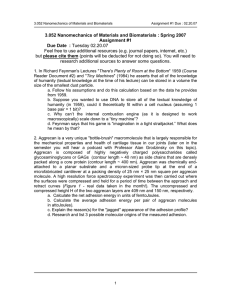


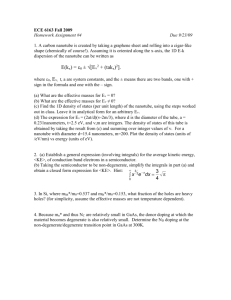
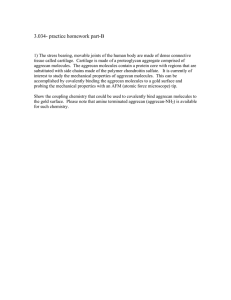
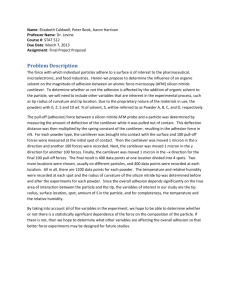
![Anti-Aggrecan ARGxx antibody [BC-3] ab3773 Product datasheet 1 Abreviews Overview](http://s2.studylib.net/store/data/012563704_1-47d596acc75ac4407e8087531fcb36a5-300x300.png)

